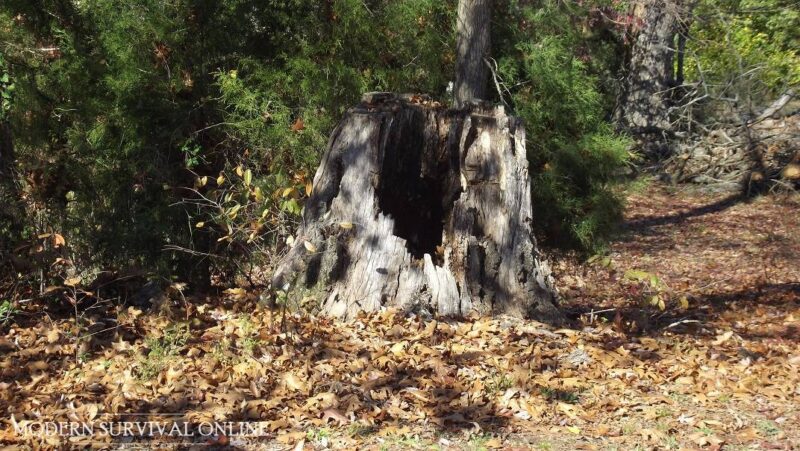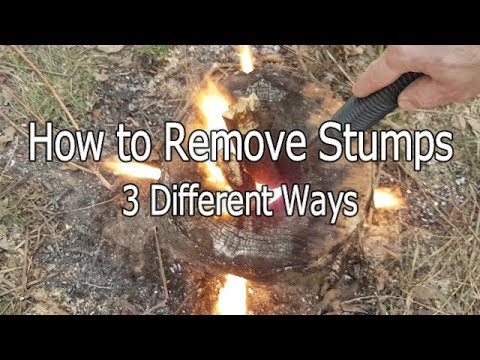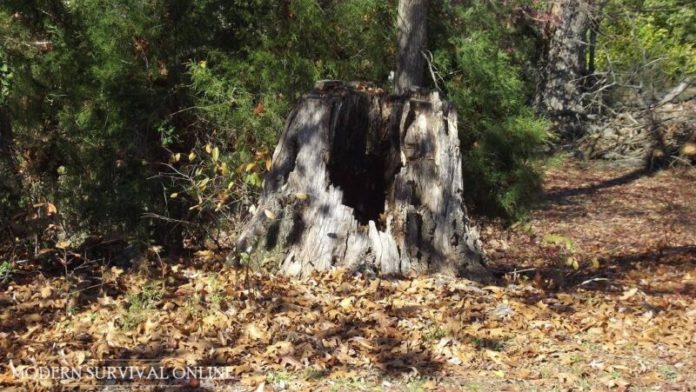If you own property you will eventually have to deal with the problem of the stumps that trees leave behind once they are cut, or knocked, down. That is just the way it is.

Due to accident, damage or deliberate intervention one way or the other trees will eventually give up the ghost and that means you’ll need to deal with the aggravating, annoying stump they leave behind.
Some folks choose to embrace the stump, and use it as a centerpiece for a kitschy, folksy landscape installation. But if that’s not you, the stump can be a problem.
It is definitely a slip, trip and fall hazard and is also a major obstacle for any kind of power lawn equipment, and is more than capable of damaging your mower should you run over it by mistake.
Second order effects you’ll need to worry about include stumps serving as excellent homes for major infestations of termites, termites that might later migrate to your house. Wasps and other critters besides will sometimes set up shop and stumps too and prove very difficult to get rid of.
There’s nothing for it: The stump needs to go! But removing it from the ground can prove to be a backbreaking endeavor if you aren’t armed with a little bit of know-how and the right tools.
In an effort to save your hands and your back, as well as a ton of time, will be providing you with the 10 easiest methods for moving a stump from your property.

Stump Grinder
A dedicated stump grinder is by far the most straightforward and generally controllable method of stump removal.
These imposing pieces of power equipment often resemble a giant chainsaw or cutter boom on a small trailer, and each massive tooth on the whirling assembly serves to hack and chisel away at the tough stump that is uglying up your property.
Use with care, as this is definitely a dangerous piece of equipment but one that is capable of dealing with the toughest, gnarliest stump imaginable.
With a few passes and a little bit of back and forth pretty soon all you’ll have left to remember that stump by is a scar in your yard and a pile of wood chippings. You can easily fill in the hole and rake up what’s left of the stump for burning or other summary disposal.
If you don’t want to mess around with other methods you should seek out a stump grinder you can rent and you can handle this yourself. It is what most of the pros use, and that is called a clue.
Power Maul / Wedges
Perhaps second only to the stump grinder in efficacy, a power maul can efficiently and quickly reduce a stump to smaller, more manageable chunks in short order with less risk associated with operation than a stump grinder.
These large contractions employ a hardened steel wedge that is driven under immense pressure into the stump to split it similar to how firewood is split using a common powered log splitter.
You’ll still have to wrestle the larger chunks out of the ground, but in operation the power maul will easily sever roots and destabilize the stump in the ground, making your life easier.
A similar method can be employed using manual hand tools and simple, wood splitting wedges. By hammering these wedges into the stump one after the other you can split the stump all the same without need of a large, heavy machine.
It is still a serious workout, but you’ll have to put in far less effort than you would attacking the stump directly with axes and picks.
Stump-Rot
It is possible to employ the scientific approach when it comes to stump removal, and there are many purpose-formulated stump removing chemicals on the market you can choose from.
These chemicals work using a variety of methods, but typically begin to break down or dissolve the wood through some sort of chemical reaction, or even introducing wood-eating fungi to the stump.
The end result is that the stump and its roots are gravely weakened and far, far easier to extricate from the soil.
Depending on the specific product you might have to do a little prep work on the stump, either drilling a hole in it or cutting furrows into the uppermost surface. Some, though, work on the stump as it is, all you need to do is pour them on and walk away.
Do take care of when employing this method if any secondary contamination of your surrounding landscaping, yard or underground water sources would be an issue.
Burn It Out
One of the more popular options for those who can employ it safely, stumps are comparatively easy to burn out of the ground.
All you need to do is split the stump a little bit, add some accelerant or additional fuel to get the fire started, then light it up and watch it burn. This works best on stumps that are already very dry, or seasoned, since they will burn better.
Another viable method is to build a large fire atop the stump which will then be consumed as fuel from above. There are some problems with this method, namely it is less and less palatable the closer your neighbors are and is definitely a bad idea during times of high wildfire risk.
Also, it can be difficult to completely burn out a stump deeply underground, so if you want total removal of the stump and its roots burning might not be the best choice.
Use a Vehicle
Using the massive torque and weight of an automobile is a viable method for yanking smaller or weakened stumps right out of the ground. All you’ll need is some strong chain or sturdy towing straps and you can get it done with a minimum of fuss and a little finesse.
The trick to employing this method is first making sure you have enough purchase on the stump. A stump that is left standing a little proud out of the ground is easier to remove via this technique then one that is cut flush or has already been chopped and hammered until it resides somewhat below the surface of the soil.
If that is the case, you’ll need to dig and excavate until you can securely fasten the straps or chains around the stump. When the time comes to pull, don’t just step on it to yank it out, as this will create a dangerous condition if your attachment point breaks.
Instead, slowly and smoothly depress the throttle until the stump starts to yield, then use a slight rocking motion to finish the job. Four-wheel drive vehicles or ones with excellent torque are best for this operation.
Cover With Compost
This is the ideal method for lazy folks, or those who have plenty of time to spare for stump removal. All that is required is covering the stump with an active compost pile and letting nature do the work.
The same forces and microorganisms that act on the food scraps, yard debris and other detritus comprising the raw materials of your compost pile will act on the stump in kind, slowly but certainly breaking it down until it is less than mulch.
All you’ll need to do then is shovel it out or leave it where it is until you can repurpose it.
This method will take a considerable amount of time, depending on your local climate, the efficacy of your compost pile and the species of wood that the stump in question is.
Generally, you should expect to give this anywhere from 6 months to 18 months to render the stump sufficiently broken down for painless removal.
Hoist
This method is similar to using a vehicle to yank the stump free, only we are pulling in a different direction. Using a vehicle mounted crane, winch or even a manual come-along or farm jack of sufficient rating it is possible to extricate a stump by plucking it right out of the ground.
Once again this method is primarily dependent upon correct setup and ensuring that your attachment method, chains or straps, is both sufficiently strong and sufficiently anchored on the stump in question.
So long as the surface area of whatever your hoist is mounted to is adequate you should be able to gradually but certainly increase tension until the root system starts to fail and let go of the soil.
Hire Stump Removers
Sometimes our ego gets in the way of our objectives, and unless you’re certain you want to do it yourself or you flat out cannot afford to hire help, your best bet for removing a stump is oftentimes to simply call professional stump removers or an arborist to do it for you.
These folks have the know-how and the expertise to assess your stump in context and then apply the right solution to minimize damage to the surrounding area and labor.
Even if you are a gung ho DIY’er consider how much your time is worth. Is this a net gain or a net loss of productivity considering how much time and sweat equity you are likely to pour into the problem of removing that stubborn stump?
Chances are it isn’t a plus, and there’s nothing wrong with calling the pros to let them handle it.
Dig It Out
You might have noticed that I have listed these methods for stump removal in order, more or less, from easiest to most difficult, and that is why this entry and the following one are at the very bottom of our list.
And certain trying, desperate or austere conditions you won’t have any other option but to remove a stump with hand tools and back breaking labor. That’s just the way it is.
If that describes your situation, or you’re a masochist, you should try digging at the stump out before you try to chop it out.
With patience, cooperative soil and some extra time it is possible to excavate dirt out from under and away from the root system anchoring the tree in place.
Without the weight and pressure of the soil to act against you’ll find the only thing you then have to deal with is the weight of the stump itself. If you do a good job, it is pretty easy to drag the stump out of the hole and process it in a simpler manner.
Chop It Out
We have come to it at last, and this method is not necessarily easy, though it is almost always achievable. Sometimes that’s enough.
If you have exhausted all other options or there’s absolutely no other tool at your disposal except that ax you brought down the tree with you can keep right on chopping into the stump and the roots to eventually remove it for good.
You’ll need to be cautious using this method, as performing any sort of chopping on a workpiece that is at or below the level of your feet means that conditions will be ripe for an accident if you miss, or if your tool glances off what you intended to strike squarely.
This can easily result in a severe injury to your foot or lower leg, so pay attention and don’t let fatigue get the better of you.
Also take great care that you don’t ruin your tool if there is gravel or stones in the soil around the stump and its root network. If that is the case you are better off using a mattock or pickaxe instead of a felling ax.
Conclusion
You don’t have to put up with an unsightly stump forever after a tree comes down, and you can make a great case for removing it for purposes of safety, not just aesthetics.
Most people rightly estimate that stump removal is a total bear, but it doesn’t have to be if you use the right method and a little ingenuity.
No matter what kind of stump you are dealing with and what kind of terrain there’s bound to be at least a couple of methods on this list that will do the trick with a minimum of cussing and effort.



